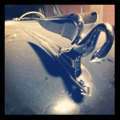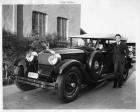|
Re: Excessive fuel consumption
|
||||
|---|---|---|---|---|
|
Just can't stay away

|
First of all, 9 MPG isn't that bad, but with a stick and overdrive you should be able to do a few MPG better, especially if you keep a steady speed and don't tax the engine.
You're going to need to play detective here, but that also means getting to use some fun diagnostic tools! My first step would be to do a major tune-up on the engine if you haven't done one recently. The major tune-up includes almost all of the investigative work you'd do for a gas mileage complaint, and it has the added benefit of turning known unknowns into known knowns, so to speak. Take a look at the Engine Diagnosis and Tune-Up Training Manual for further detail. It's impossible to isolate a cause without doing some investigation, and with a new (to you) car, it could well be multiple small things adding up. Some of these would also result in other symptoms, so that could help pinpoint the issue. Some causes: -Faulty carburetion -Incorrect initial ignition timing -Low compression -Faulty distributor mechanical advance -Restricted air cleaner -Faulty/leaking vacuum advance
Posted on: 2016/8/8 2:02
|
|||
|
||||
|
Re: Unleaded
|
||||
|---|---|---|---|---|
|
Just can't stay away

|
At high engine speeds and loads, exhaust valves get hot. At high temperatures, the valves actually form micro-welds with the seats each time they close. When they open, these micro-welds are broken, displacing minuscule amounts of material and creating a rough surface which would slowly abrade the seat. Small, but over 1,000s of miles it adds up. Lead protected exhaust valve seats by forming a coating on the valve and seat, just like it coated everything else, in gunk. That microscopic coating of lead and lead oxide acted as a buffer against the micro-welding process.
However, lead use also resulted in a whole host of other issues, such as regular spark plug fouling, engine oil contamination, ring sticking, and exhaust system rust-out. The worst thing that can happen to an engine that runs unleaded is that it'll need a valve job. In pretty much anything made before the early 50's today's 87-octane regular gasoline is more than sufficient from an octane requirement perspective. You should be aware that almost all octane-boosting additives use alcohol as their active ingredient.
Posted on: 2016/6/27 10:24
|
|||
|
||||
|
Re: Sealing 41 Windsheild
|
||||
|---|---|---|---|---|
|
Just can't stay away

|
The proper sealant is 3M bedding and glazing compound (WindowWeld). It's available at NAPA auto parts and most other name brand stores, though it may be special order since it's not used much on modern cars.
Put it in a caulking gun and consider reinforcing the nozzle/tip with a piece of metal so you can really shove it under the gasket. The best way to seal a gasket windshield is to line the gasket with strip caulk in the channel before installing the gasket on the glass, and then to use the sealer once the glass is installed as well.
Posted on: 2016/5/18 15:18
|
|||
|
||||
|
Re: radio etc
|
||||
|---|---|---|---|---|
|
Just can't stay away

|
Many radios can be brought back to life if you change a vibrator or a tube or two, but you'll have repeated issues unless you really go through it and replace all the capacitors and check and service the radio properly. A good job takes time and some know how, and while servicing the radio is something most people are capable of with the right tools (tube tester, soldering iron, new capacitors, replacement tubes, replacement solid state vibrator, etc.), there are lots of folks out there who specialize in servicing antique radios and can do the job fast and relatively inexpensively. Dan Skidmore in Los Angeles has been running a top notch radio repair service for the Studebaker community for a number of years (he advertises occasionally in Turning Wheels), he did my Packard radio four years ago and it's been working like a champ ever since. If you can find someone like that locally, who'll put the radio back to stock (not one of those folks who just gut the thing and replace it with modern internal a, yuck!), you'll be back and running, grooving away in no time.
Incidentally, there are a number of products on the market which allow you to keep your radio stock but add on an auxiliary mini (headphone) plug input. My personal experience with the RediRad has been excellent and it's allowed me to plug my iPhone in for long drives to get some good old tunes booming through the great tube radio in my car. If you have any desire to rally have a useful radio, consider one of those products as well.
Posted on: 2016/4/24 0:24
|
|||
|
||||
|
Re: How does car insurance work for Packards or any antique car?
|
||||
|---|---|---|---|---|
|
Just can't stay away

|
The primary difference between most classic car insurance policies and your "daily driver" policies is the coverage limit for collision and comprehensive (and uninsured motorist). Some of the terms and minimum coverage requirements vary by state, but almost all policies have those coverage categories in common. Classic car policies, the good ones, at least, are Agreed Value policies; you and the insurer have agreed on the value of your vehicle/the amount you'd receive in the event of a total loss. Daily driver policies are Actual Cash Value (ACV) policies and pay you the insurers estimation of the market value of your car LESS your deductible. ACV policies work well for new cars because they depreciate somewhat predictably, the market is large enough to generate solid estimates of value, and identical model vehicles are pretty much identical. That's obviously not the case with old cars, so most of us prefer to know what we'll get if we have a total loss.
Indeed, as long as the damage is less than the coverage limit, they'll cover the repairs to your car, often the complete cost because many classic car policies have a $0 deductible. Some insurers, such as Hagerty, have experts dedicated to sourcing those hard-to-find parts. They'll pay to put the car back as it was, provided that cost doesn't exceed the agreed value. Of course if the cost of repairs does exceed the limit you'd set, then they'll just write you a check for the agreed value, so it's important to set that value accurately and to review it regularly. There are some limitations on use, and going to the grocery store may be frowned upon by some of the more restrictive insurers (the commonality in all policies I've reviewed is that you can't use your car for daily driver duty). In that case you'd still be covered for liability, but you'd be in violation of your policy agreement, which could result in a bit of a fight for coverage. Hagerty is the market leader and their restrictions make sense - limited daily use is permitted, you can even drive your car to work occasionally if you want, but it can't be your everyday car. It's important to know exactly what your insurers requirements and restrictions are so you don't run afoul of their limitations, but in general the policies are set up to cover all perils you'd likely experience.
Posted on: 2016/3/4 12:50
|
|||
|
||||
|
Re: Various CL Pickings
|
||||
|---|---|---|---|---|
|
Just can't stay away

|
What's the deal with the badging on the front fenders on that '52 400? I don't recall seeing that on other 52s.
Posted on: 2016/2/27 12:07
|
|||
|
||||
|
Re: Redline/Maximum Continuous Operating RPM - Packard 6 Cylinder Engines
|
||||
|---|---|---|---|---|
|
Just can't stay away

|
Your gut is probably going to be your best source of guidance here. If you're looking to maximize the life of your engine, staying at or below the speed at which it feels like you're pushing it is the best course of action. Truthfully, that's all anyone really had to go on back when the cars were new, and given how long your car has been in service, any number of things could have lowered or raised the safe operating range. Anecdotally, I can say it's been my experience that almost any of these cars from the mid-30's onward will comfortably maintain 50 MPH all day long.
And, in fact, there are probably other practical limits that come into play as well around that speed. Consider the bias ply tires, the limit of your brakes, your fuel consumption, the ability to maintain steering control, the capacity of the cooling system, and your tolerance for noise. A few points of anecdotal reference: -When we took a 1936 Standard 8 Phaeton to Pasadena for the Rose Parade, we drove it on the freeway and just cruised along at 50 most of the way. For me, 55 felt like I was pushing it just a bit (especially after a guy cut me off), but 50 felt comfortable. More than that and the steering also got a little scary. Different tire size but a similar final drive ratio to the six you reference. -We had a 1940 120 sedan on the PAC All-Western Regions tour last year. 60-65 was no problem, but 70 felt like a stretch to that driver. -A properly tuned Model A Ford will run at 45 MPH all day long, and at that speed your distance and time are only limited by your capacity to tolerate noise, vibration, and harshness. Faster and the engine temp will start to climb.
Posted on: 2016/2/23 7:16
|
|||
|
||||
|
Re: Various CL Pickings
|
||||
|---|---|---|---|---|
|
Just can't stay away

|
That '53 upholstery was never intended to replicate a Packard color-- the car was supposed to have the grey interior, based on the data plate. I think the previous owner had that color done because it was inexpensive. It's more maroon in person, but it's still weird, and its synthetic velour, so...yeah. The headliner and the "b" pillar panels seem original to the car.
The car has a windshield sticker from the CHP roadside emissions inspection program, which is probably why someone thought that meant it had been a CHP car.
Posted on: 2016/2/11 17:23
|
|||
|
||||
|
Re: Various CL Pickings
|
||||
|---|---|---|---|---|
|
Just can't stay away

|
Two Packards out of the Automobile Driving Museum (where I volunteered until last June) are up for sale.
1953 Patrician http://losangeles.craigslist.org/wst/cto/5440716736.html 1940 120 Sedan http://losangeles.craigslist.org/wst/cto/5429814158.html Given how few details are mentioned in the ads, I'm not convinced the guy representing them for the museum knows the cars...for starters, the '53 never was a CHP cruiser...but maybe you can swing a deal with them.
Posted on: 2016/2/11 12:18
|
|||
|
||||








